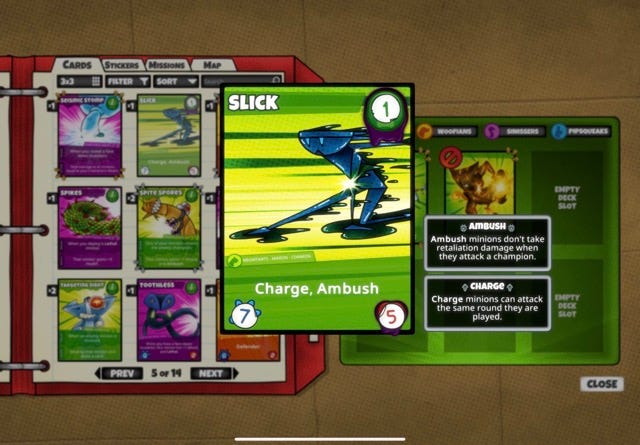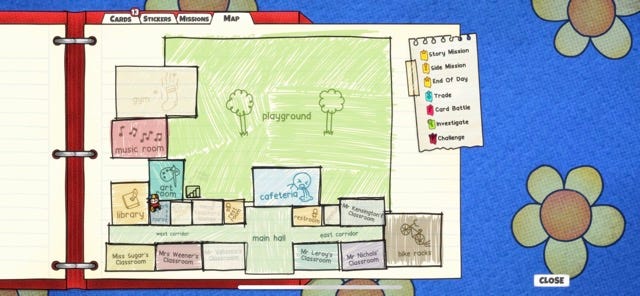Nerdstalgiapocalypse
Can Cardpocalypse recapture the magic of playing Pokemon as a kid?
This week we're looking into Cardpocalypse, another of Apple Arcade's 2019 launch titles. It’s a follow-up title to Gambrinous Games’ other card battler: the 2015 Guild of Dungeoneering. In Cardpocalypse, you play as a new kid in elementary school, where the hot new card game Power Pets is all the rage. After inadvertently getting the game banned you have to complete a series of quests to earn your cards back while investigating the mysterious disappearances at the school.
The game is split into two parts: an RPG where you spend your time talking to your friends and teachers, and a card battle game. The card battle game is a simplified version of Magic: The Gathering. It consists of the pets (creatures), mutations (spells), and the champions who lead your strategy. With four different factions to choose from, there are different strategies you can play, depending on your preferences.
Quick Thoughts
Cardpocalypse captures the powerful and free feeling of playing card games as a kid.
It uses a lot of smart UI/UX tricks to help the player out and make them feel smart while they play
The beginning of the story is a bit slow, but it ties itself together nicely in the end.
This game makes absolutely no sense as a launch title for a mobile-first service.
You should absolutely play this game.
Nostalgia is Everything
Nostalgia continues to be a force in modern pop culture, and I would argue there are two basic types of nostalgia. There's the carbon copy nostalgia which is taking the same work and rebooting or extending it for a new generation or a new era. You can look at things like The Fantastic Beasts saga in Harry Potter, the explosion of Pokemon Go, or the fact that there's a literal reboot of the 1990s version of the X-men cartoon. The premise of this nostalgia is pretty obvious: you liked it, here’s more.
Then there's the emotional/referential nostalgia. This type of nostalgia is harder to pin down, as the goal isn't to recreate a specific brand or character but to take a set of themes and reimagine them in a new era. This nostalgia is harder to pin down and riskier to create because it's new. It tries to take an element of the past and then reimagine it using modern language but with the spirit of the old references.
Cardpocalypse is more this second type of nostalgia. It hits almost all of the major plot points of the 90s and 00s. The fad, the moral panic, the multi-media integration. I spent a lot of my time in the game doing favors for kids, getting my cards confiscated, rebuilding my collection, and even trading candy and cards with other kids. It captures the idea that the game wasn’t the only way to be part of the experience.
Cardpocalypse is at its best when it captures the expansive, freewheeling spirit I felt playing card games as a kid. Playing Magic: The Gathering as a kid on long bus rides into school felt freeing. Like each card was a connection to a larger realm if only I could understand the correct combinations of strategies to unlock its true potential. On top of that, our feelings about the rules were that they were there to make the game fun (often that meant whatever was most likely to help us win).
Cardpocalypse captures this feeling by allowing you to break the rules in special ways throughout the story. It starts with the stickers. Early on, you get a pack of stickers that allow you to modify the cost, health, and attack of the cards you apply them to. These small, permanent tweaks let you boost your deck and make the experience uniquely your own. In pure game design terms it “breaks” the game. But in experiential terms, it feels great.
On top of that, throughout the game, you get to create your own card and splice two cards together. Drawing those cards was always a huge rush because they’re so powerful and also because I made them myself. And towards the end of the game, you get to add special rules that change how the game is played like making certain types of minions cost more or less, or having players start with extra food (the name of the resource in the game you use to play cards). This rewards you for thinking about the types of decks you want to build while reinforcing the theme of modification and customization of the game.
Sophisticated UI
While the mechanics are a throwback to an earlier era, the game's UI takes advantage of all of the new innovations that make card games feel modern. When you open up a card you get the full view with helpful tooltips popping up next to the card. The names of the keywords are indicative of the type of effect: i.e. a keyword like "Revenge" references an effect that will happen after the card is destroyed.
Navigating around the school also has some clever elements which make it easier to play the game. If you pop open the menu to figure out the locations of the school, you can view the different individuals in each room, with a helpful icon describing what interaction you can have with them. Then, if you double-click the room, you will "fast travel" to that location. This UI shortcut lets you easily jump between rooms to track down the different missions.
These are smart tweaks that make the game feel new while still tapping into that sense of nostalgia.
Part of Your World
The other part of card games as a kid was playing along with the TV shows. YuGiOh was my show of choice. I still remember that one episode where Yugi has to create some sort of random infinite combo with Kuriboh to prevent Kaiba from defeating him. The important piece here is that the combo has absolutely nothing to do with what's on the cards. It's some combination of the visuals and the feeling of what's on the cards, put together for dramatic effect. The slipping of the line between the game and real life.
Cardpocalypse understands this too.
Spoilers Ahead…
I’m going to get into some stuff that talks about later sections of the game. Feel free to jump ahead if you don’t want to find out.
.
.
Sharing Interlude
If there’s a friend you think would like to read more about Cardpocalypse or Apple Arcade, share it with them!
Interlude Over
.
.
In the final two levels, you end up battling the champions of the games themselves. You bounce around the school, discovering and defeating the different power pets champions And it brings together all the themes of the games, banning the game, running favors, solving a mystery, turning it into that ultimate of childhood dreams: becoming part of the story of the game you play.
Does it belong in Apple Arcade?
The indie game nerd in me wants the answer to be yes, but I think the correct answer is no. In short, Cardpocalypse doesn't feel like it was designed for a phone. There are quite a few places where playing the game on a phone touchscreen slows the game down and makes it close to unplayable. If I didn’t have an iPad or the amazing Backbone controller, I’m not sure I would have been able to finish it.
Navigating around rooms on a phone requires tapping a location, waiting for your character to move to that spot, and then tapping again. In larger rooms, this meant tapping and waiting five or more times just to talk to a single character. And the small tabs of the main menu (the screen where you modify your deck and view your missions) do not feel like they were built for a phone.
I don't want to blame the developer for this either. Their other title Guild of Dungeoneering had a very successful port to iOS and was a great title to play on the phone.
The way the UI works makes it feel more like Apple threw a bunch of money at a finished game so they could put it on their new service (Apple Arcade) without investing the time to make sure the game felt native to the main console on the service (the iPhone).
The End
Ultimately, Cardpocalypse hit a great balance between nostalgia, a bunch of cool mechanics, and a story that almost but not quite dragged on too long. It's currently available on most major platforms, and I'd recommend looking outside of Apple Arcade if you're interested in taking a look.
How did you like this article? Was there anything you’d like to see more of? Less of? Let me know in the comments!










You really nailed it on highlighting the nostalgia of adding your own spin on a game. As kids, we all played similar "core" games, but we all had our own versions of them. Being able to modify the game rules and invent new tools/combos/moves not only ignites creativity and imagination, as you pointed out, it feels really special when you see your creation or modification come into play. Great review!